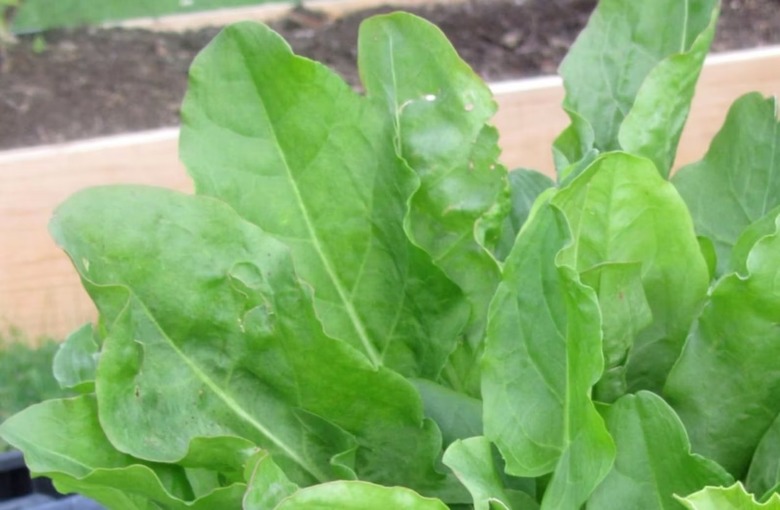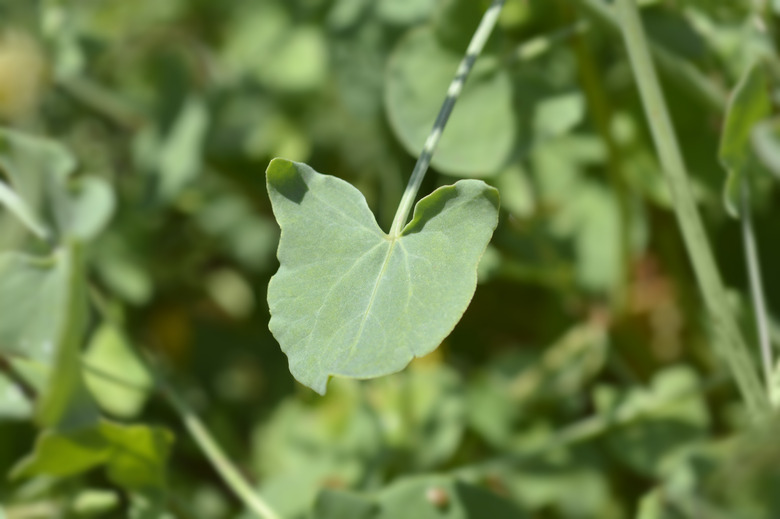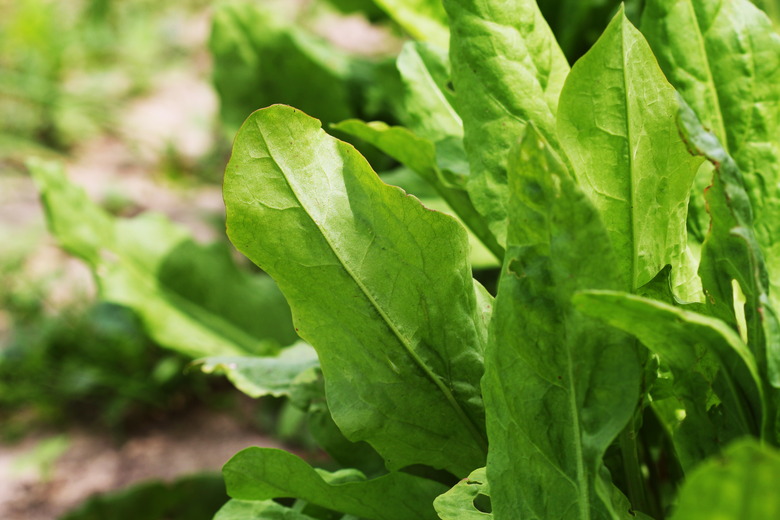How To Grow French Sorrel
We may receive a commission on purchases made from links.
For a different twist on your usual salads, add some zesty French sorrel (Rumex scutatus). This leafy green vegetable is not only a low-maintenance gem to grow but it's also high in potassium and vitamins A and C. If your garden is in U.S. Department of Agriculture plant hardiness zones 5 through 9, you'll be able to grow French sorrel as a perennial plant.
French sorrel, together with other types of sorrel, is botanically classified in the buckwheat plant family (Polygonaceae), which also counts rhubarb (Rheum x cultorum, zones 3-8) among its members. French sorrel and garden sorrel (Rumex acetosa, zones 3-7), also known as common sorrel, are the two most commonly cultivated members of this genus. The primary differences between the two species are size and taste. French sorrel is shorter (6 to 12 inches) and less acidic, and garden sorrel is taller (18 to 24 inches) with a stronger acidic taste.
Best Uses for French Sorrel
Best Uses for French Sorrel
Fresh sorrel leaves have a lemony flavor that adds a tang to fresh as well as cooked foods. New leaves harvested early in the season may not be as flavorful as the mature leaves harvested later in the season. Regardless of when you harvest, you'll still taste the characteristic lemony flavor.
You may not want to make a salad entirely with fresh sorrel, because of the acidic taste. There is also a high level of oxalic acid contained in the leaves that can be detrimental in large quantities, locking out other nutrients in the food you eat, such as calcium. This high concentration of oxalic acid can also be problematic to anyone prone to kidney stones, arthritis or rheumatism. To be on the safe side, use fresh sorrel leaves as an accent among other leafy greens in your salads instead of using it as the primary salad ingredient.
An alternative to enjoying fresh sorrel leaves in your salads is cooking the leaves, which reduces the oxalic acid content. Serve hot sorrel soup with crusty rolls on a cold winter's day, sauté it with other veggies and serve it over pasta or rice, or steam the leaves as you would other leafy greens. As a culinary heads up, sorrel leaves may discolor cooking pots and pans (particularly aluminum and iron), silver serving dishes, and carbon steel knives because of its high acid content.
Because of its mounded shape and compact size (12 inches or shorter), French sorrel can be grown in many different types of sunny garden spots. Although it's an edible crop, it also works beautifully among ornamental plants. This means that you won't have to relegate it to the vegetable or herb garden; you can even use it as an edging plant to outline your flower bed. If you grow it in containers, it works just as well in a mixed planting as it does as a standalone plant.
How to Grow French Sorrel
How to Grow French Sorrel
Starting French Sorrel From Seed
Start sorrel seeds indoors about three weeks before the last frost in your area. You can also direct sow the seeds into your garden in early spring. Here's how to plant French sorrel seeds:
- Sow seeds 1 inch deep in a soilless seed-starting mix with ingredients such as coir, vermiculite or perlite and keep the mix moist but not wet until the seeds germinate.
- Place the seed-starting tray or individual pots in bright light, preferably in front of a sunny window.
You'll be able to begin harvesting the young leaves about 60 days from a spring sowing. If you leave the seed stalks on the plants, you may find that your French sorrel will self-seed. Thin the seedlings when they sprout so the plants do not become overcrowded, which can restrict their growth. Crowded plants also experience reduced air circulation around each clump, which may keep French sorrel leaves damp and invite diseases.
Starting French Sorrel From Seedlings
Transplant seedlings after the last frost date in spring when there is no danger of freezing temperatures that may damage the tender seedlings. When setting transplants in the garden, space them at least 12 inches apart. Take care not to set the transplants any deeper than they were growing in their pots so that you do not bury the crown, which can lead to rot. If you start French sorrel from seed or if your plants self-sow, thin the seedlings to this same distance apart.
In What Zone Does French Sorrel Grow Best?
In What Zone Does French Sorrel Grow Best?
Although French sorrel grows as a perennial in USDA plant hardiness zones 5 through 9, gardeners in colder zones can grow it as an annual. Plants grown in the warmer zones may tend to bolt quicker. "Bolting" means they'll send up flower stalks that produce seeds, which may cause leaf production to decline. However, if you remove these flower spikes, plants might continue to produce leaves for harvest.
One cultivar that does not produce seeds, which means it won't bolt, is 'Profusion' (Rumex scutatus 'Profusion'). By not producing seeds, 'Profusion' fulfills its name by continuing to produce lots of leaves all season long.
In cooler regions or marginal areas within French sorrel's hardiness range, you may want to protect early transplants from frost injury with floating row covers or other lightweight fabric. Uncover plants in the morning when temperatures rise above freezing and cover them again before sundown.
When Should You Plant French Sorrel?
When Should You Plant French Sorrel?
By sowing seeds or setting out transplants in spring, you'll enjoy a longer growing season, but you can also plant French sorrel throughout the growing season. As long as it becomes established before the cool temperatures arrive in autumn, particularly around the time of the first frost, French sorrel will overwinter throughout its hardiness range. If, however, your garden is outside this range, the earliest possible planting date yields the most harvestable leaves during the growing season.
Soil, Sunlight and Water Recommendations for French Sorrel
Soil, Sunlight and Water Recommendations for French Sorrel
French sorrel is adaptable to many types of soil, including those made of sand, clay and loam as long as the soil drains well. This plant grows to its potential on soil that stays moist without becoming waterlogged. Aim for the goal of moist, well-draining soil that's rich in organic matter. Keep the soil pH between 5.5 and 6.8 for best results.
Full sun is optimal, although French sorrel tolerates partial shade. If you don't have a suitable sunny spot in the garden, you may have a sunny patio or deck where you can grow this plant in a container.
You'll be able to harvest lots of leaves when you keep the soil moist so that French sorrel can maintain its cut-and-come-again production of leaves. Thoroughly saturate the soil around your plants to a depth of at least 1 inch per week throughout the growing season. If you're growing plants in containers, you'll need to water more than this because the soil in containers dries more quickly than in-ground soil. Water container plants when the top 2 inches of soil is dry.
How to Propagate French Sorrel
How to Propagate French Sorrel
Other than seeding new plants, you can also divide established plants to propagate more French sorrel for your garden. By lifting out clumps of French sorrel with a shovel or spading fork, you can separate individual plants within each clump or slice through a single mound and separate into sections.
If the divisions are larger, you can replant them directly in the garden. If you have small divisions, you may want to pot them up and keep them moist and in a semi-off shady location until they're large enough to transplant to the garden.
You can divide French sorrel clumps at any time during the growing season, but spring-divided plants have the growing season to become established before cool weather to better withstand winter temperatures.
How to Winterize French Sorrel
How to Winterize French Sorrel
French sorrel typically dies to the ground during winter and re-emerges in spring except in mild regions across its perennial range, where you may be able to harvest leaves year-round. Cover plants with straw mulch or a mixture of straw and compost, particularly across marginal areas in its hardiness zones, to protect it from extreme winter temperatures and rake back the mulch when the plant begins to emerge in spring.
How to Harvest French Sorrel
How to Harvest French Sorrel
In areas with mild winters, you may be able to harvest French sorrel leaves throughout the cold season, but in most climates, you'll harvest sorrel only during the warm growing season. From early spring until fall, when frost kills the top growth, harvest the green leaves simply by picking them individually.
The leaves are best when fresh, but you can freeze them if your harvest exceeds your real-time needs. Since French sorrel dies back at the end of the growing season, you'll be able to freeze lots of leaves for adding to hearty winter soups.
Common Pests and Other Problems of French Sorrel
Common Pests and Other Problems of French Sorrel
French sorrel has an amazing facility to withstand pests and diseases. Aphids may be occasional pests, but you can control them without chemicals by spraying them off with your garden hose or a water wand.
One problem that's characteristic of French sorrel is its toxicity to dogs, cats and horses. If an animal ingests a small amount, the consequence may be an upset stomach. However, if an animal ingests large amounts of the leaves at a time or repeatedly eats the leaves, French sorrel can cause weakness, seizures and secondary renal injury.
If you have a curious dog or cat that loves to nibble on your garden plants, you may want to grow French sorrel surrounded on all sides by a wire barrier so that the sun and water can get through but your dog or cat is excluded.
Common Diseases of French Sorrel
Common Diseases of French Sorrel
The only diseases that may be troublesome to your French sorrel plants are crown rot or root rot, both of which are fungal diseases and are generally preventable. To prevent crown rot, plant French sorrel so that its central crown is at soil level or slightly above. To help prevent root rot, make sure the soil drains well.
Planting in raised beds is an appealing option for areas with poorly draining soil. When you water French sorrel plants, it's better to direct water near the root zone instead of using overhead irrigation. Otherwise, the leaves may stay wet and harbor fungal pathogens.


